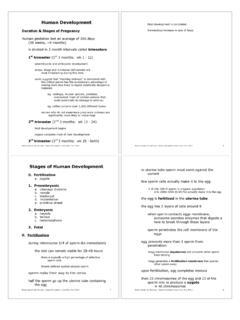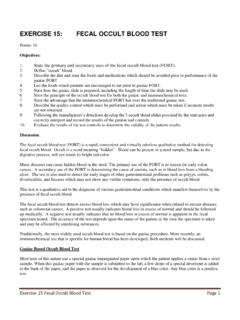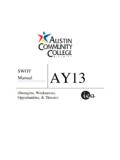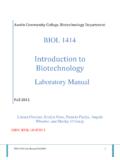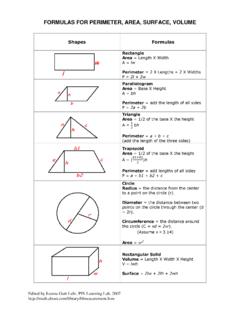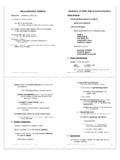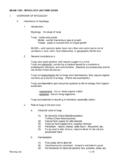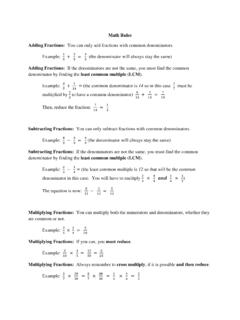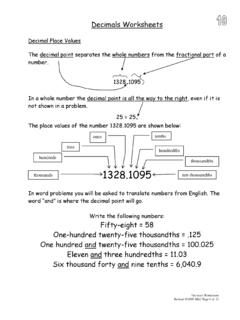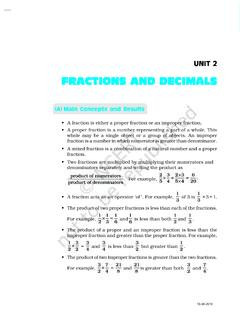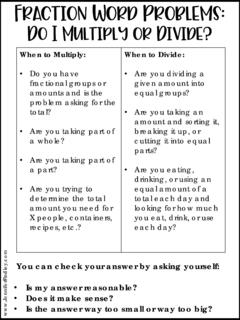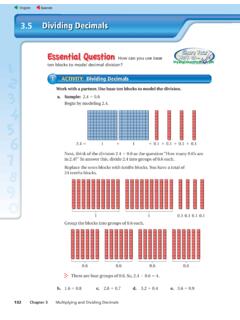Transcription of MATH REVIEW FOR MEDICATION DOSING
1 1 MATH REVIEW FOR MEDICATION DOSING After the completion of this module you will be able to: Identify the parts of a fraction. Determine the value of a fraction compared to another fraction. multiply fractions and reduce product to lowest terms. Identify the names of each place value of numbers in relation to a decimal. Convert a fraction to its decimal equivalent. Safely determine when to round up or down when computing dosage calculations. KEY TERMS Apothecary Measurement System: Measurement system for weighing drugs and solutions which uses both Roman and Arabic numerals together with fractions to identify parts of the unit of measure.
2 To express an amount less than one, fractions are used. Denominator: The number on the bottom portion of the fraction that represents the number of parts into which the whole is divided. Dividing Line: The line separating the top portion or the fraction from the bottom portion of the fraction. Household Measurement System: Measurement system commonly used in cookbooks and recipes, which uses whole numbers and fractions . It is considered the least accurate measurement system because of the differences between measuring devices. It is also known as the Customary Measurement. Leading zero: Referred to as the additive identity.
3 Used before a decimal notation to add emphasis to the presence of a decimal. Metric Measuring System: A decimal system of weights and measures based on units of ten in which gram, meter, and liter are the basic units of measurement. The gram and the liter are used in MEDICATION administration. Numerator: The number on the top portion of the fraction that represents the number of parts of the whole fraction. Roman Numerals: A numeral system originating from Rome adapted from Etruscan numerals. Based on certain letters which are given values as numerals. Scored Tablet: A tablet with one or two grooves that divides the tablet in half or in four quarter sections of equal size.
4 2 fractions As a healthcare provider, you may have to interpret prescriptions written with fractions . Therefore, it is important that you are able to understand what the fraction represents and to manipulate it in order to provide the correct dosage for a patient. REVIEW of fractional parts A fraction is a number that represents part of a whole number and contains three parts: numerator, dividing line, and denominator (devisor). If these are mixed up, you can cause series injury to your patient. X Y Value of a fraction Sometimes it may be necessary to determine the value of a fraction compared to another.
5 You can do this using three methods: 1. When the denominators are the same, the fraction with the highest numerator has the highest value. 41 vs. 43 2. When the numerators are the same, the fraction with the lowest denominator has the highest value. 81 vs. 161 3. When there is no common numerator or denominator in each fraction, convert each fraction to its decimal equivalent so that you can compare the value of the two fractions . 31 vs. 53 31= 53= Multiplying and Reducing fractions In order to administer medications safely, it is important to be able to multiply and reduce fractions .
6 When multiplying fractions , remember to 1. multiply the numerators. 2. multiply the denominators. 3. Reduce the product to the lowest terms. 6232213221= = numeratordividing line denominatorhighest numerator highest value lowest denominator highest value highest decimal highest value 3To reduce a fraction, divide the numerator and the denominator of the fraction by the same largest whole number that will divide into both numbers. In the above example, the largest whole number that will divide into both numbers is two. Therefore, 312622262= = Thus, 31623221== SAFETY ALERT: It is very important to calculate the lowest term correctly so that you do not dose a patient incorrectly.
7 DECIMALS Place Value System Early civilizations in China and India used an Abacus to help them with establishing place value. This is where our current Place Value System of numbers comes from. Each numeral in a decimal number has a value based on its location from the decimal point. Place Value Table 5 4 3 2 1 . 1 2 3 4 Ten Thousands Thousands Hundreds Tens Ones Decimal Point Tenths Hundredths Thousandths Ten Thousandths Increasing Value Decreasing Value SAFETY ALERT: It is very important to always include the leading zero to a decimal that does not have a whole number. This will help you to avoid potential life threatening errors when you are calculating a drug dose.
8 Converting a Fraction to a Decimal Many students have what is termed fraction phobia and would prefer to avoid fractions all together. Most of the time, it is a good idea to change a fraction into a decimal because it can make your math seem easier to compute. You can do this by dividing the numerator by the denominator using your calculator: = 4 Multiplying Decimals When you need to multiply a decimal number, simply : 1. multiply as if the numbers were whole numbers. (don t worry about the decimals yet) X 2. As you compute the problem, place the last digit of each additional product to the left of the previous product s last digit.
9 1 2 X 0125 000 000 3. Then add the products together. 1 2 X 0125 000 000 . 00125 4. In order to place the decimal point in the correct spot, count the number of digits to the right of each decimal in the problem. X A total of four digits are to the right of each decimal. 5. Count an equal number of digits in the answer starting from the left and place the decimal point there. 1 2 X 0125 000 000.
10 6. If there are fewer digits in the answer than the total number of decimal places needed, you must add zeros to the left of the answer digits. Dividing Decimals 5 Let s first REVIEW some terms: 1. divisor - In a/b = c, b is the divisor 2. dividend In a/b = c, a is the dividend 3. quotient In a/b = c, c is the quotient Example: 3/2 = Quotient . Divisor 2)3 Dividend Here s another example. In order to divide decimals you must remember one important thing: the Divisor must be a whole number. Dividend : Divisor Quotient In order to make the decimal a whole number you must: 1.

